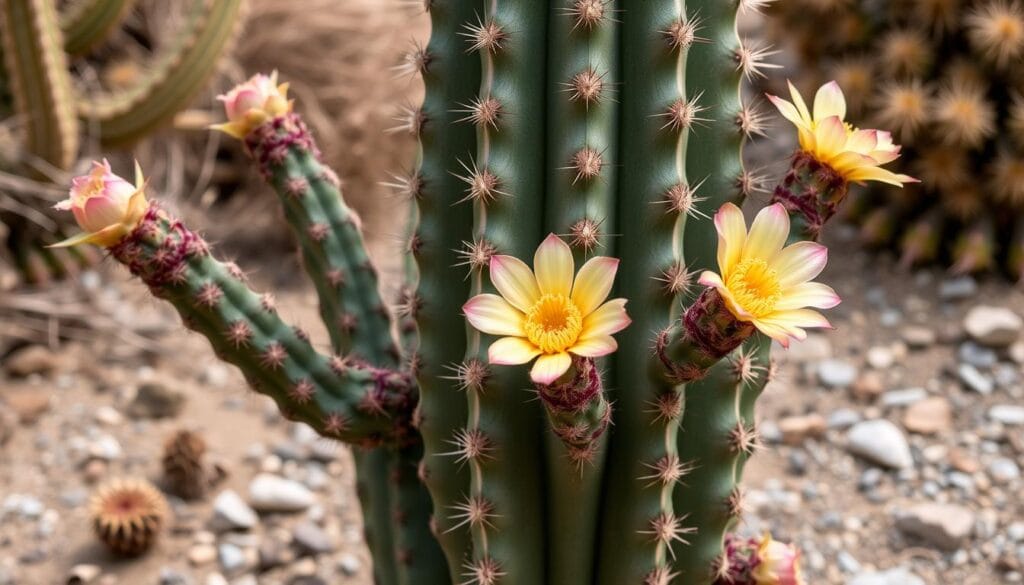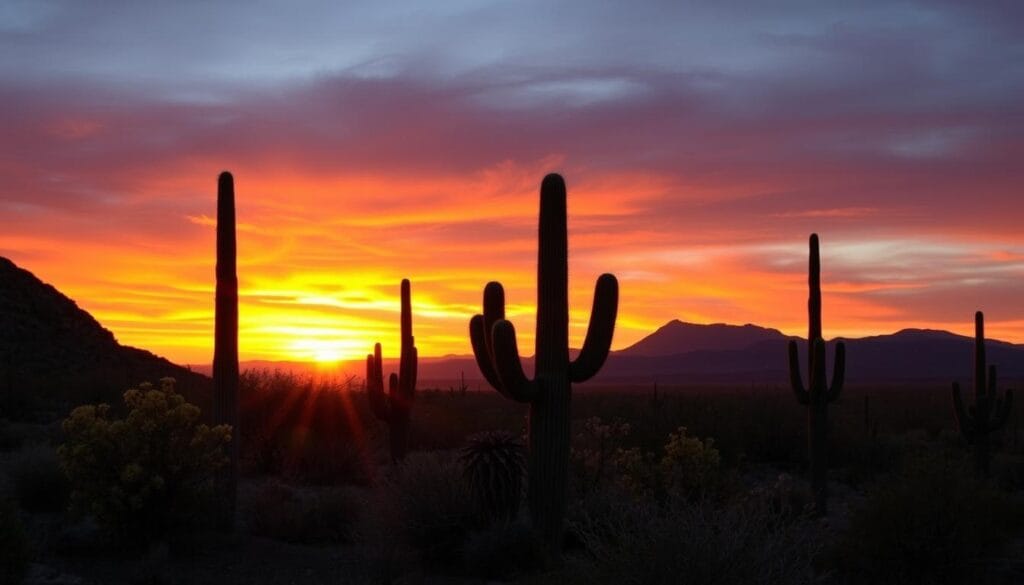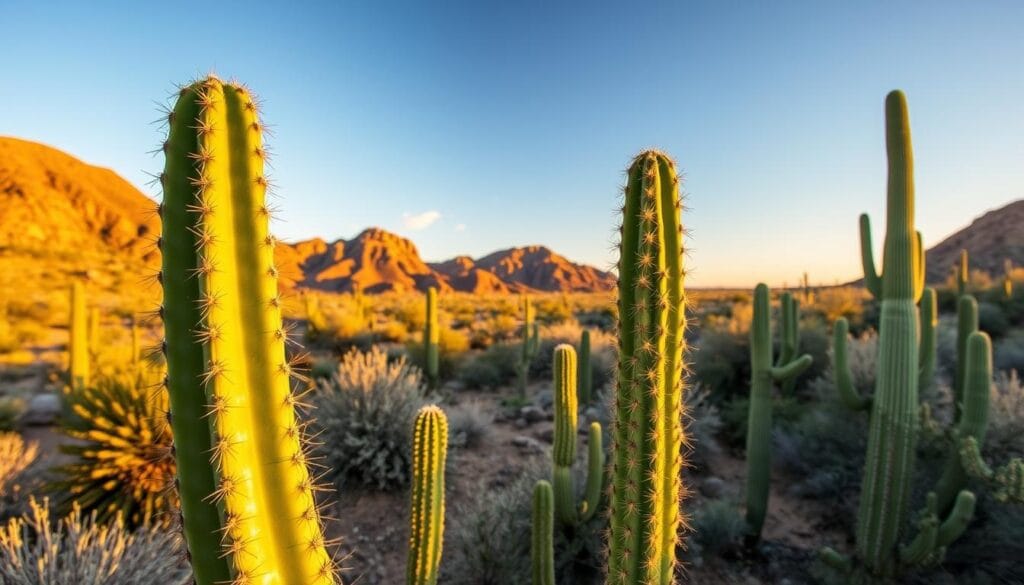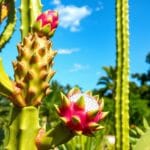Did you know the Organ Pipe Cactus is a symbol of endurance in Native American and Mexican traditions? It plays a key role in keeping the desert ecosystem balanced. This plant not only shelters wildlife but also helps prevent erosion with its wide root system1. Exploring Stenocereus thurberi, I’m amazed by its unique ways to survive in the harsh Sonoran Desert.
The Organ Pipe Cactus thrives in Arizona’s hot summers and mild winters. It loves the low humidity and lots of sunlight, making it great for photosynthesis. These cacti are also popular for indoor decor and water-saving landscaping.
As I learn more about this Sonoran Desert plant, I’m impressed by its many roles in the ecosystem. The Organ Pipe Cactus is a keystone species, supporting biodiversity and possibly offering medicinal benefits. Native cultures have used it for treating diabetes and high cholesterol1.
Key Takeaways
- Organ Pipe Cactus is a symbol of resilience in Native American cultures
- It plays a vital role in maintaining desert ecological balance
- The cactus thrives in Arizona’s hot, dry climate
- It’s popular for both indoor and outdoor landscaping
- Native cultures use it for medicinal purposes
- The plant helps control erosion through its root system
- It’s a keystone species supporting desert biodiversity
Introduction to the Organ Pipe Cactus (Stenocereus thurberi)
The organ pipe cactus, also known as pitaya in Mexico, is a unique plant in the Sonoran Desert. It has been a key resource for poor communities for centuries. It’s used for food and building materials2.
Unique characteristics and appearance
Organ pipe cacti stand out with their multiple stems and short trunk. They can live over 150 years, growing about 2.5 inches each year. These cacti bloom for the first time at 35 years old, showing white flowers in May and June3.
Natural habitat and distribution
Organ pipe cacti are rare in the U.S. but common in the Sonoran Desert. The Organ Pipe Cactus National Monument has the largest U.S. population. They grow on south-facing rocky slopes within a 40-50 mile radius north of the monument3.
Significance in desert ecosystems
In the desert, organ pipe cacti are vital. They adapt to extreme temperatures and water scarcity. Their relationship with pollinators like birds and insects is essential for the desert2.
| Use | Indigenous Groups |
|---|---|
| Fuel | Cáhitas, Guarijíos |
| Fences | Pimas, Seris |
| Building Materials | Cáhitas, Pimas |
| Medicine | Seris, Guarijíos |
| Food | All mentioned groups |
Organ pipe cacti face threats from habitat loss for agriculture and shrimp farming. Saving these cacti is key for the Sonoran Desert’s balance and indigenous culture2.
The Sonoran Desert: Home of the Organ Pipe Cactus
I love exploring the vast Sonoran Desert, where the majestic organ pipe cactus grows. This desert covers parts of Arizona, California, and northwestern Mexico. The Organ Pipe Cactus National Monument, created in 1937, safeguards a big part of this area, spanning 517 square miles4.
The organ pipe cactus is well-suited to the desert’s harsh conditions. It can handle extreme heat and little rain. Summer days can hit over 100°F, and winter nights can drop to 40°F4. These cacti can grow up to 20 feet tall and 12 feet wide, making them the second-largest cactus in the U.S5.
When I visit the monument, I see the amazing variety of life. You’ll find saguaros, creosote bushes, and the rare elephant tree4. The desert blooms in late spring to early summer. The organ pipe cactus then blooms with white to pale lavender flowers, drawing in pollinators5.
The Organ Pipe Cactus National Monument is a wildlife paradise. I’ve seen desert bighorn sheep, javelinas, and the endangered Sonoran pronghorn. Bird lovers will enjoy seeing Gila woodpeckers, cactus wrens, and hummingbirds4.
Climate change is a big challenge for this ecosystem. Since 1950, the area’s average temperature has risen by 3 degrees Fahrenheit. This affects the monsoon seasons and extends droughts6. Yet, the organ pipe cactus still thrives, showing nature’s strength against adversity.
Organ Pipe Cactus National Monument: A Protected Haven
I’ve always been fascinated by the Organ Pipe Cactus National Monument. This unique sanctuary in the Sonoran Desert is home to an incredible variety of cacti. It has 31 different species, from towering saguaros to tiny pincushions7.
Establishment and Purpose
The monument was created to safeguard the diverse flora and fauna of the Sonoran Desert. Its centerpiece is the organ pipe cactus, a columnar cactus that can grow up to 20 feet tall and 12 feet wide8. These majestic Sonoran Desert plants can live for about 150 years, serving as living witnesses to the ever-changing desert landscape7.
Visitor Experiences and Activities
When I visit, I’m always amazed by the variety of activities available. Hiking trails wind through the desert, offering breathtaking views of the diverse cacti. The park usually charges between $25 to $35 per vehicle for admission, which I find reasonable for the experience9. Scenic drives allow me to explore the monument’s beauty from the comfort of my car, while camping areas provide a chance to immerse myself in the desert environment overnight.
Conservation Efforts within the Monument
The monument serves as a living laboratory for scientists studying desert ecosystems. They focus on understanding climate change impacts on desert plants like the organ pipe cactus. This columnar cactus has adapted uniquely to its environment, using nighttime carbon fixation for photosynthesis to conserve water8.
| Cactus Species | Height | Interesting Fact |
|---|---|---|
| Organ Pipe Cactus | Up to 20 feet | Blooms after 35 years |
| Saguaro | Up to 45 feet (record: 78 feet) | Grows 1 inch in 10 years |
| Teddy-bear Cholla | 1-5 feet | Known for protective spines |
| Pincushion | Up to 8 inches | Some as small as golf balls |
The monument’s efforts to preserve these unique Sonoran Desert plants ensure that future generations can experience the awe-inspiring beauty of the organ pipe cactus and its desert companions.
Adaptations for Desert Survival
The Organ Pipe Cactus, or Stenocereus thurberi, is a marvel of desert adaptation. It has evolved unique features to thrive in harsh, arid environments. Its survival tactics are truly fascinating.

One of the most striking features is its height. These cacti can tower up to 20 feet, creating an impressive silhouette against the desert sky1011. This height isn’t just for show – it’s a crucial adaptation that helps the plant survive.
The Organ Pipe Cactus has a waxy outer layer that prevents water loss. Its shallow root system quickly absorbs rainwater, while its pulpy flesh stores large quantities of water. These adaptations allow it to thrive in the Sonoran Desert’s extreme conditions.
During drought or extreme temperatures, this cactus enters a state of dormancy. It significantly reduces water intake, showcasing its ability to endure harsh conditions10. This survival strategy is key to its longevity, as healthy Organ Pipe Cacti can live for over 50 years under optimal conditions10.
The cactus’s slow growth rate is another adaptation to its water-scarce environment11. This measured pace allows it to conserve resources and survive for decades. Its perennial nature means it blooms multiple times throughout its life, typically from late spring to early summer1011.
Sharp spines serve a dual purpose: they provide shade and protect the cactus from herbivores. These adaptations, combined with its unique photosynthesis pathway, make the Organ Pipe Cactus a true survivor of the desert landscape.
Growth Patterns and Lifecycle
The organ pipe cactus (Stenocereus thurberi) has amazing growth patterns and a unique lifecycle. I’ve found some interesting facts about its journey from seedling to adult.
Seedling to Maturity Timeline
An organ pipe cactus starts with germination, which happens in 2 to 4 weeks at 70°F to 85°F. At first, these small cacti are 1 to 2 inches tall and stay that way for 1 to 2 years12.
Growth Rate and Longevity
Once it starts growing, the organ pipe cactus can grow 1 to 3 inches a year. This stage can last 10 to 20 years before it reaches full size12. It’s interesting to compare this to the saguaro cactus, which can grow up to 40 feet tall, with some reaching 60 to 78 feet13.
Reproduction and Flowering
The flowering season of the organ pipe cactus is truly a sight to see. These cacti start flowering around 5 to 10 years old, with blooms in late spring to early summer. Each flower lasts only 1 to 2 nights, making it a brief but beautiful event12. Desert plants like the organ pipe cactus have evolved unique ways to survive in harsh conditions.
| Growth Stage | Duration | Characteristics |
|---|---|---|
| Germination | 2-4 weeks | Optimal temperature: 70°F-85°F |
| Seedling | 1-2 years | Height: 1-2 inches |
| Vegetative Growth | 10-20 years | Growth rate: 1-3 inches/year |
| Flowering | Begins at 5-10 years | Flower lifespan: 1-2 nights |
The organ pipe cactus’s ability to produce offsets for propagation adds another layer to its reproductive strategies. This ensures the continuation of this remarkable species in the desert landscape12.
The Organ Pipe Cactus in Indigenous Culture
The organ pipe cactus is a key part of indigenous traditions in the Sonoran Desert. The O’odham people of southern Arizona have loved this cactus, called “chuhuis,” for thousands of years.
This cactus is crucial to O’odham culture. It gives them food, building materials, and many other products. They make preserves, syrup, and even wine from its fruit. Their calendar is based on the cactus’s life cycle.
Today, O’odham people still gather fruit in the Organ Pipe Cactus National Monument. This place, created in 1937, covers 517 square miles. It welcomes about a quarter of a million visitors each year14.
“The organ pipe cactus is not just a plant; it’s a living connection to our ancestors and our way of life.”
These cacti can grow up to 20 feet tall and 12 feet wide15. They can live for up to 150 years, watching over generations of O’odham traditions14.
| Aspect | Organ Pipe Cactus | Cultural Significance |
|---|---|---|
| Native Name | Chuhuis | Reflects deep cultural connection |
| Uses | Food, Construction, Beverages | Integral to traditional lifestyle |
| Cultural Calendar | Based on cactus lifecycle | Guides seasonal activities |
| Modern Practice | Fruit harvesting in monument | Preserves ancestral customs |
The cactus blooms from late spring to early summer. Its flowers are white to pale lavender15. This matches O’odham cultural events, showing their bond with the desert’s natural cycles.
Pollination and Ecological Relationships
I’m fascinated by the intricate pollination process of the organ pipe cactus (Stenocereus thurberi). This desert beauty has evolved unique relationships with its pollinators. These relationships ensure its survival in harsh environments.
Nocturnal Pollinators: Lesser Long-nosed Bats
The organ pipe cactus has a special bond with nocturnal pollinators, especially the lesser long-nosed bat. Its large, fragrant flowers bloom at night, reaching up to 10 inches in length16. These white or cream-colored blossoms emit a sweet scent that attracts bats seeking nectar.
The tubular shape of the flowers allows easy access for these winged visitors. This enhances pollination success16.
Daytime Pollinators and Visitors
While bats are the primary pollinators, the organ pipe cactus doesn’t limit its options. During the day, bees, moths, and hummingbirds also play crucial roles in pollination16. This diverse array of pollinators ensures the cactus’s reproductive success.
The flowering season typically runs from April to July. This provides ample opportunities for pollination17.
Seed Dispersal Mechanisms
After successful pollination, the organ pipe cactus produces fruit. When ripe, these fruits split open, revealing red pulp studded with seeds. Various animals feast on the fruit, aiding in seed dispersal.
Wind and water also contribute to spreading seeds across the desert landscape.
The pollination and seed dispersal of the organ pipe cactus are vital for its survival. However, urbanization and habitat loss pose significant challenges to pollinator populations16. Conservation efforts are crucial to protect this beautiful cactus and its ecological relationships in the Sonoran Desert.
Threats and Conservation Challenges
The Organ Pipe Cactus, a stunning Sonoran Desert plant, faces many threats. Climate change is a big risk to this iconic species and its home. Over 75% of all cacti species are declining due to global environmental changes, including shifts in climate patterns18.
In the Organ Pipe Cactus National Monument, researchers see changes in monsoon seasons and less winter moisture. These changes affect the cactus’s growth and survival. The International Union for Conservation of Nature reports that 31% of evaluated cacti species are listed as near threatened, vulnerable, endangered, or critically endangered19.

Habitat loss is another big worry for the Organ Pipe Cactus. As humans take over desert landscapes, these plants lose their homes. Illegal harvesting also hurts wild populations.
Conservation efforts at Organ Pipe Cactus National Monument aim to protect large stands of this unique cactus. Ongoing research tries to understand how the species might adapt to changing climate conditions. Scientists are especially interested in the cactus’s Crassulacean acid metabolism (CAM) photosynthetic pathway, which helps it thrive in CO2-enriched environments19.
| Threat | Impact | Conservation Action |
|---|---|---|
| Climate Change | Altered monsoon seasons, reduced winter moisture | Monitoring environmental changes |
| Habitat Loss | Reduced natural living space | Protecting large stands in national monument |
| Illegal Harvesting | Decreased wild populations | Increased surveillance and enforcement |
By tackling these challenges, we can help ensure the survival of the majestic Organ Pipe Cactus. This way, future generations can still admire and study it in its natural Sonoran Desert habitat.
Unique Phenomena: Cristate Organ Pipe Cacti
I’ve always been fascinated by rare and beautiful natural mutations. The cristate organ pipe cactus (Stenocereus thurberi) is a wonder in the Sonoran Desert. These unique formations add wonder to the stunning Organ Pipe Cactus National Monument.
Causes and frequency of cristate formations
Cristate, or “crested,” organ pipe cacti are rare. While exact numbers for organ pipe cacti aren’t available, we can look at similar species for context. In the case of saguaro cacti, only about 2,000 crested specimens have been documented throughout the Sonoran Desert20. This rarity makes spotting a cristate organ pipe cactus a truly special event.
The cause of this unusual growth pattern is still a bit of a mystery. Some experts think it might be linked to frost damage, especially in the northern parts of the Sonoran Desert20. This theory fits well with the organ pipe cactus’s habitat, which includes the Ajo Mountains where cold snaps can occur.
Significance and beauty of cristate cacti
Cristate organ pipe cacti are not just rare; they’re also incredibly beautiful. The fan-shaped crest at the tip of the cactus arm creates a striking visual contrast to the typical columnar growth. While we don’t have specific measurements for organ pipe cacti, crested saguaros can have crests spanning 3 to 5 feet across, with some reaching up to 9 feet20. It’s amazing to think that these unique cacti, including the organ pipe cactus, continue to thrive and reproduce just like their non-crested counterparts20.
As I explore the Organ Pipe Cactus National Monument, I’m always on the lookout for these rare beauties. The cristate organ pipe cactus, like its cousin the Myrtillocactus geometrizans found in central Mexico, showcases nature’s ability to create stunning variations21. These unique cacti remind us of the diverse and resilient life forms that call the Sonoran Desert home.
FAQ
What is an organ pipe cactus?
Where can I find organ pipe cacti growing naturally?
What is the significance of the organ pipe cactus in the desert ecosystem?
How tall can an organ pipe cactus grow?
When does the organ pipe cactus flower?
What is the lifespan of an organ pipe cactus?
How does the organ pipe cactus adapt to the desert environment?
What are the primary threats to the organ pipe cactus?
What is a cristate organ pipe cactus?
Source Links
- Symbolism and Benefits of the Organ Pipe Cactus
- Review of The Organ Pipe Cactus by David Yetman
- Victoria Mine & Alamo Canyon Hikes – Evans Outdoor Adventures
- Organ Pipe Cactus National Monument | Park, Wildlife, Sonoran Desert | Britannica
- Organ Pipe Cactus ‘Stenocereus thurberi’
- Organ Pipe Cactus – Organ Pipe Cactus National Monument (U.S. National Park Service)
- Cacti – Organ Pipe Cactus National Monument (U.S. National Park Service)
- Organ Pipe Cactus ‘Stenocereus thurberi’
- Organ Pipe Cactus National Monument – Rubber Tramp Artist
- 🌵 Organ Pipe Cactus: A Perennial Plant
- 🌵 Organ Pipe Cactus Is Not an Annual
- 4 Facts About Organ Pipe Cactus Lifecycle 🌵
- Cactaceae (cactus family)
- Organ Pipe Cactus National Monument – Time.Travel.Trek.
- Organ Pipe Cactus ‘Stenocereus thurberi’
- 🌵 Step-by-Step Guide to Pollinating Organ Pipe Cactus
- Charismatic Cacti Giants
- Global change impacts on cacti (Cactaceae): current threats, challenges and conservation solutions
- Photos: Inside the Bizarre World of the Crested Saguaro Cactus
- Explore Unique Cactus for Sale at Ponderosa Cactus | Tucson, AZ


